Review: OnePlus 5T
Dec 12, 2017, 12:30 PM by Eric M. Zeman
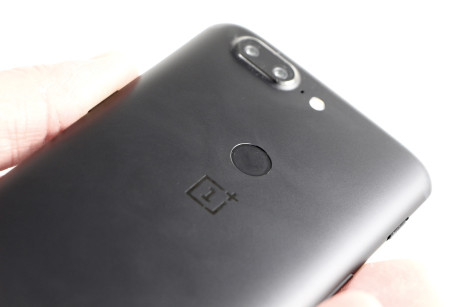

The latest smartphone from OnePlus is an attractive, affordable premium device. The OnePlus 5T is the latest handset to adopt the 2:1 aspect ratio and offer a dual-camera array. With a Snapdragon 835 under the hood and OnePlus' tasteful tweaks to Android, the OnePlus 5T is an appealing blend of price and performance. Here is Phone Scoop's in-depth review.
Hardware
Is It Your Type?
The OnePlus 5T tweaks the winning formula of the OnePlus 5 by adding a 2:1 display and adjusting the dual cameras. If you want near-flagship performance at less-than-flagship cost, the OnePlus 5T is an affordable option to Galaxys and iPhones.
Body
Editor's Note: The OnePlus 5T is nearly identical to the OnePlus 5, with only a few minor hardware changes. Some of the text below is carried over from our earlier review of the 5, though all relevant portions have been updated to reflect the changes.
The 5T is very similar to the OnePlus 5 from earlier this year. In fact, other than the revised aspect ratio of the screen and relocated fingerprint sensor, the devices are nearly identical.
The 5T is a metal-and-glass slab that comes in black. It has gently rounded corners and a smooth shape. The front includes 2.5D curved glass and it sits in an aluminum chassis that wraps around the back and all four sides. The 5T borders on generic, yet the simple lines are appealing in their own way. Antenna lines appear along the top and bottom edges, but they are hardly noticeable. I like the matte finish.
The 5T is above average in terms of size for a modern handset. OnePlus stretched the height by a few millimeters to accommodate the 6-inch, 2:1 screen. The 5T is tall at 6.15 inches, but the width isn't too bad at under three inches. The profile is very slim, so it fits in pockets with ease. Some people may struggle to use the phone one-handed. Anyone looking for an all-screen phone should expect a device to be about this size. The weight is a few grams more than the older 5, but it's not bad.
Hand Fit
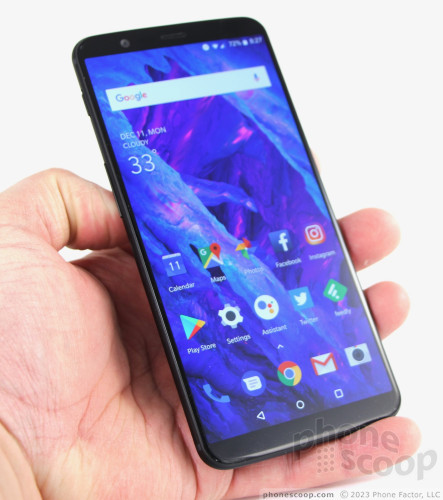
What it comes to materials and build quality, the 5T competes well. There's no question the front curved Gorilla Glass 5 is excellent, and the aluminum chassis feels strong and sturdy. The pieces are fitted together perfectly. The phone conveys confidence and quality.
The 5T has a plain black face with no branding. The metal grille of the earpiece speaker is practically invisible, though the user-facing camera is rather obvious. I'm really happy OnePlus reduced the bezels on the 5T; the forehead and chin above and below the screen are tight. The 5T doesn't quite deliver a bezel-less experience of some devices, but it's much more appealing than the OnePlus 5. OnePlus was forced to move the fingerprint reader from below the screen to the rear. This allowed the company to adjust the screen ratio without increasing the size of the phone too much.
I've long appreciated the ringer switch on OnePlus handsets and I'm happy to report it's still available on the 5T. The three-position switch is tucked into the left edge and it lets you control the phone's sound (on / vibrate / silent). This is a great feature that more phones should offer. The switch has a ribbed texture that makes it easy to find, and the action is perfect.
Alert Slider
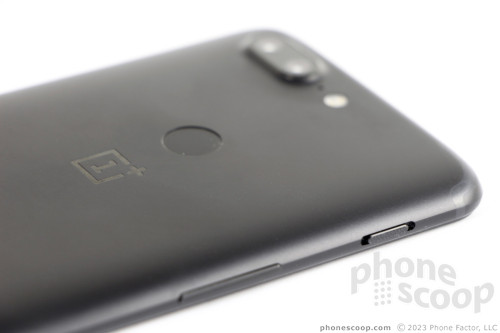
The volume toggle is just below the ringer switch on the left edge. It has a decent profile and length. Travel and feedback are okay; I was hoping for more snap. You'll find the screen lock / power button on the right edge of the phone. The button is small, but it has a good profile anad delivers pleasing feedback. The SIM card tray is tucked above the screen lock button on the right. The metal tray supports up to two SIM cards, but it doesn't accommodate memory cards.
A USB-C port is positioned on the bottom edge. It's flanked by the 3.5mm headphone jack and the speakerphone. Surely some will be happy about the headphone jack, a feature that's becoming rare on high-end devices.
Bottom Edge
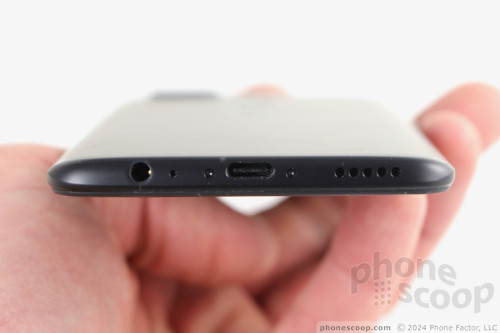
The rear aluminum panel is curved gently. The center section of the metal is mostly flat, though it rounds off near the side edges of the phone. It's simplicity at its best. The fingerprint reader is indented just a tiny, tiny bit. I didn't have any trouble finding it while testing the phone. The dual camera array is in the upper-left corner. The camera module is raised quite a bit from the metal surface, which means the phone sits unevenly on hard surfaces.
Camera Bump
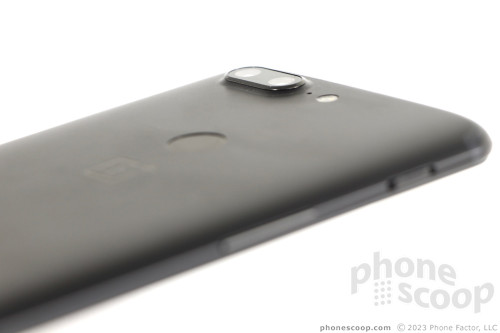
Thanks to the all-metal chassis, you cannot open up the OnePlus 5T. The battery is inaccessible, but this shouldn't surprise anyone at this point.
This phone is not waterproof, which is a major bummer. It's not rated rugged, either; you may want to wrap it up in a case.
The evolution of OnePlus' handsets has been swift. The company adopted the 2:1 aspect ratio screen for its flagship in lockstep with the competition. The high-quality materials and the svelte design ensure that the 5T is hard to ignore.
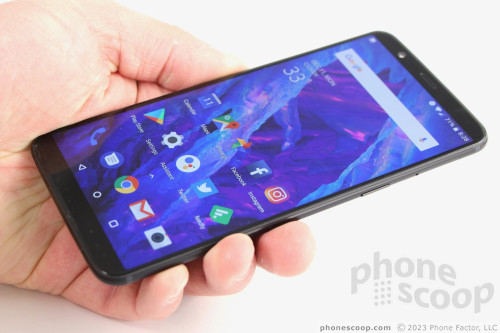
Screen
OnePlus is the most recent phonemaker to jump from the 16:9 aspect ratio to 2:1 (18:9) for its high-end device. The 5T's screen measures 6 inches across the diagonal and offers full HD+ resolution, or 2,160 by 1,080 pixels. High-end 2:1 screens from Samsung, LG, and Google may offer quad HD+ resolution, but I think the 5T does just fine with the pixels it has. I was pleased with pixel density, and on-screen elements look sharp.
The display relies on AMOLED technology to provide its luminescence. I found the screen to be plenty bright for normal use. It handled indoor and outdoor duties without difficulty. The automatic brightness controller is very aggressive at raising the brightness when outside. That's great for visibility, but can impact battery life. Colors look good on the screen and are mostly accurate. Viewing angles are very good; there's very little color/brightness change when you tilt the phone.
OnePlus included a calibration tool so you can set the screen to your preferred appearance. There are four preset hues, and one custom for adjusting white balance and color saturation.
Signal
OnePlus sells the 5T unlocked with wide support for GSM/LTE networks here in the U.S. and abroad. It supports most of the major LTE bands used by AT&T and T-Mobile, even bands 29, 30, and 66. (The phone lacks CDMA 1900 and LTE band 13, so it won't work well — if at all — with Verizon and Sprint.) You'll find speedy technologies such as Cat. 12 LTE, three-channel carrier aggregation and 256QAM.
I tested the phone on both AT&T and T-Mobile and came away impressed. The phone handily latched onto AT&T and T-Mobile's 4G networks and remained there throughout testing. Data speeds were robust, but didn't reach the peaks I've seen from today's best phones. In real world terms, the OnePlus 5T was able to stream video via YouTube and music via Spotify with no trouble. I saw little to no buffering and didn't experience any dropouts or pauses. It's a good data phone.
As for making phone calls, the handset was able to patch through on the first dial each time I made a call. Calls stayed connected over miles of highway driving.
Sound
I'd rate call quality as very good. The earpiece produces clean calls that are free of distortion and noise. As with the 5, I wish volume were just a bit better. I had to keep the volume set to the maximum in order to hear calls in most places. Voices sound nice and crisp, even if they're not quite loud enough. People I spoke to through the OnePlus 5T said I sounded very good.
The speakerphone is more prone to distortion when cranked up, and — like the earpiece — needs to be set all the way up most of the time. The speakerphone was hard to hear in moving cars and other noisy spaces, but it sufficed for use at home.
Ringers and alerts could be a little louder. The vibrating alert is one of the best.
Battery
The OnePlus 5T carries over the 3,300 mAh battery from the OnePlus 5. After several weeks of testing there's no doubt that this battery is well-matched to the phone. The result is a handset that I had trouble draining during a day of rigorous testing. Most people should be pleased with the battery life they get from the OnePlus 5T.
The handset includes the standard Android power-management tool. It can help a bit if you suddenly find yourself at 10%. The OnePlus 5 also includes a new tool called App Priority. The phone's software will close or put into low-power mode apps that it thinks aren't being used.
More importantly, the 5T supports OnePlus' Dash Charge technology (5 volts at 4 amps) for rapid power-ups. It charges faster than any other phone I've tested.
Bluetooth, GPS, NFC, WiFi
You'll find Bluetooth 5.0 aboard. When it came to connecting to headsets, speakers, cars, and other devices, the OnePlus 5T got the job done. The phone paired with little effort. Phone calls passed through my car's hands-free system were decent.
Music, on the other hand, sounded amazing when streamed to my favorite headphones. The phone supports aptX HD, which is the newest high-resolution stereo Bluetooth codec. As long as you have a compatible piece of audio gear, expect your ears to be happy.
The GPS radio and Google Maps got along like bosom buddies. The 5T was able to pinpoint my location within just a few seconds, and accuracy was as good as about 15 feet. The phone managed real-time navigation with no trouble.
The NFC radio supports Android Pay and also helps it pair with Bluetooth accessories.
The dual-band WiFi radio supports 2x2 MIMO for faster throughput if you have a solid WiFi router. The WiFi worked amazingly well no matter what hotspot I hopped on.
Software
Lock Screen
The phone includes Ambient Display, which wakes the screen with simple notifications when messages or emails arrive. The screen is on for a couple of seconds before it blinks off again.
Lock Screen

You can double-tap the screen to wake the phone. The lock screen includes the time, date, and list of notifications. It's basically the stock Android lock screen experience. The notification screen also includes shortcuts to the phone and camera apps. You can't customize these shortcuts, which is a shame.
One of the new additions in the 5T is facial recognition for unlocking the phone. Similar to how this feature works on Samsung and Apple phones, you'll need to spend a minute recording your face up close. Once the software has captured your mug, the phone will automatically unlock if it recognizes you as you lift the phone up. It works very well, much better than I had anticipated. The speed is on par with Apple's Face ID, though OnePlus' software isn't nearly as secure.
There's also the rear-mounted fingerprint reader, which works flawlessly. I was able to set up several prints and the phone recognized them each quickly and accurately. The fingerprint reader is top-notch and is the quickest way to unlock your phone.
The ringer switch works together with software to help manage notifications. I like that you can map certain types of notifications to certain positions of the switch, such as whether text messaging creates an audio alert or a vibration. You can also select from a wide array of vibration patterns.
There's also an LED indicator light, which can be set to blink specific colors for specific types of messages or other notifications.
Menus
OnePlus calls its Android interface skin OxygenOS. The OnePlus 5T basically runs a near stock version of Android 7.1 Nougat with powerful OnePlus software tools on top. (OnePlus says the 5T will get Android 8 Oreo early in 2018.) The real benefit of OxygenOS is that it tosses in a huge number of settings for customizing the phone's behavior.
Home Screen
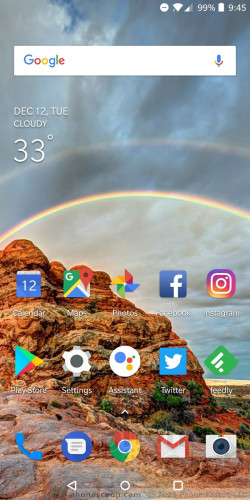
The home screen panels function as they would on any other Android phone. That means they accommodate wallpapers, shortcuts, widgets, and so on.
The left-most home screen is the Shelf, which is a customizable space where you'll find what matters most or what you use most. LG and HTC have similar tools built into their Android skins. It's sort of like Google Now. By default, it shows the local weather, a shortcut for writing a note, and several app suggestions that change over time. You can turn it off completely if you want.
Core interface functions, including the app drawer, Quick Settings shade, and main settings menus, all look and work as they do on any stock Android phone.
There are gobs of extras. For example: Dark Mode. It's meant for use at night. Dark Mode changes what are normally white screens to black, and black text to white. It primarily impacts menus and other system screens; it does not change apps. I like that you can adjust the accent colors.
OxygenOS provides OnePlus 5T owners with plenty of control over the status bar. You can select exactly which app icons are displayed in the status bar and which are not and even do things like tweak the shape of the battery meter.
Like LG handsets, the OnePlus 5T lets you choose the orientation of the Android controls. You can pick back-home-switch, or switch-home-back. The software home button and back/switcher keys on the display support long-press and double-tap shortcuts for opening select apps. You can even elect to turn on support for drawn gestures. For example, using your finger to draw a "V" on the screen will turn on the flashlight. The possibilities for customization are nearly endless.
You simply can't ask for better performance. The OnePlus 5T has a Snapdragon 835 processor on board with either 6 GB or 8 GB of RAM. This is the best CPU/RAM combination available on phones right now, and is found in more expensive phones like the Google Pixel 2 and LG V30. The OnePlus 5T delivers blistering speed. I couldn't find any activities that caused the phone to break a sweat.
Camera
There are a handful of ways to start the camera. The fastest will always be to double-press the power button or fingerprint sensor. The app opens in a blink.
Camera
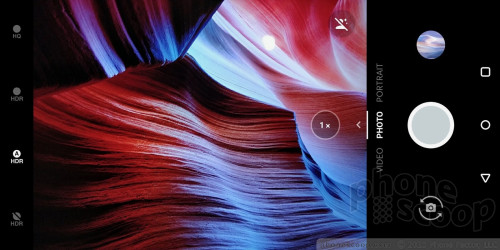
You'll notice controls lined up on the sides of the viewfinder, including toggles for the flash, aspect ratio, HDR, and timer on the left. I like that the HDR and flash functions both include an “auto” option. Aspect ratio options include 4:3, 16:9, and 1:1. You'll need to shoot in 4:3 to access the full pixel count of the camera sensor.
Three shooting modes are available by swiping up/down on the home screen: photo, video, and portrait. Other modes available (by swiping the viewfinder to the left) include time-lapse, slow motion, pro, and panorama.
Portrait mode is all the rage on smartphones these days and is meant to help you capture great shots of people's faces. Portrait mode relies on the dual camera lenses to provide sharp focus on the subject while blurring the background so the subject "pops". The mode is simple to use; just point the OnePlus 5T at your family/friends and hope for the best.
The "pro" mode is an advanced manual mode for taking full control over the camera's individual behaviors. When in pro mode, you can set shutter speed (up to 30 seconds), focus, white balance, brightness, and ISO. Easy-to-decipher dials help you select what's best, and the screen previews the type of exposure you should get with those settings.
The camera app's settings menu is somewhat buried in the screen with the advanced shooting modes.
In all, it's a fairly straightforward camera application to use. Perhaps most importantly, it's quick and light on its feet. I didn't notice any sluggish behavior from the camera and that makes me happy.
Photos/Video
OnePlus did something at once interesting and perplexing with the 5T's camera configuration. Like high-end iPhones, the OnePlus 5 included a standard lens and a telephoto lens. This gave you some actual optics to help zoom in on far-away subjects. For whatever reason, OnePlus kept the two-camera system for the 5T but replaced the telephoto lens with a low-light lens. I'm at a loss to explain why. Taking good low-light pictures isn't as viscerally appealing as, say, awesome zoom or super wide-angle shots.

The main camera relies on a 16-megapixel Sony IMX398 sensor at f/1.7. This is, in fact, the exact same main sensor found in the older OnePlus 5. The secondary sensor relies on a 20-megapixel Sony IMX376K sensor, also at f/1.7. The pixels in this sensor are smaller, but OnePlus says four of them can work together in low light to create a more sensitive "superpixel" to capture more information with less grain.
There's no doubt in my mind that the OnePlus 5T produces pictures that are superior to those of the OnePlus 5. (Let's not forget that OnePlus has spent the past five months tweaking the camera software.) The 5T takes sharper photos that have less grain. Exposure and color are about on par with what I saw on the 5. While the 5T is better than its older brother, it's not quite up to par with today's top phones.
As for low-light performance, there's a clear improvement. The 5 took terrible low-light photos. The 5T takes decent low-light photos. I think the iPhone X, Pixel 2 XL and Galaxy S8 are better in low-light, but the 5T holds its own. The images show much, much less grain than those taken with the OnePlus 5. You'll see less banding and more detail. As much as I like the improvement, it's hard to account for the loss of a dedicated telephoto or wide-angle option.
Low Light

The portrait mode produces results that are in line with competing devices. The delineation between subject and background can sometimes be uneven or over-obvious. Even so, the results are sure to please some people. The other modes (pano, timelapse, slo-mo) do a fine job.
Portrait

The front camera has a 16-megapixel Sony IMX371 sensor at f/2.0. It does a decent job. I was mostly pleased with self-portraits. If you care to, you an enable beautification tools for smoothing over skin blemishes. A screen-based flash helps provide some light in the darkest settings. It suffices for most selfies, though I've seen better from devices like the (pricier) iPhone X and Pixel 2 XL.
On the video front, the 5T captures up to 4K video. You can dial in a handful of different resolutions and frame rates to suit the style you're looking for. The footage I shot was clean, sharp, colorful, and properly exposed. I saw only the smallest amount of grain in low-light spaces. The front camera is limited to full HD video and it looks good, too.
Wrap-Up
The 5T is OnePlus' finest handset yet. It may be a minor update to the 5, but it's the right update. The 5T adopts the modern screen shape and accounts for the missteps of its predecessor's camera to deliver a more well-rounded and competitive device.
The 5T has a tall footprint to accommodate the larger 6-inch screen, though I think trade-off is well worth it. Around the display you'll find a simple, yet pleasing, piece of metal hardware that looks as good as it feels. Other positives include good signal performance, stellar battery life, and the right selection of ports/jacks.
OnePlus' variant of Android is perhaps the best on the market. It leaves the core functionality in place while adding a wide range of useful controls and tools. The revised camera software is even easier to use than that of the 5, and, more importantly, the 5T takes even better pictures.
The OnePlus 5T is available online and is sold unlocked for $499. It's about the same price point as the Motorola Z2 Play. You're not going to score Galaxy S or iPhone performance from the OnePlus 5T, but you'll spend $300 less and still come pretty close. If you prefer unlocked phones and want to keep costs down and performance up, the OnePlus 5T finds the right mix of both.
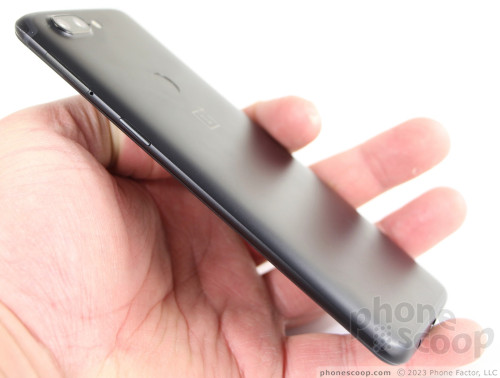
Comments
OP 5T notification light
With OxygenOS you can pick one of 8 colors for notifications and opt to turn on or off per app (e.g. you want SMS to flash, but not weather channel), but it is just one color. The review makes it sound like you can pick colors for various things: "There's also an LED indicator light, which can be set to blink specific colors for specific types of messages or other notifications."
In practice 3 of the color choices are "battery full, battery charging, battery low" and the 4th choice is "default notification."
to clarify- this is not like Cyanogen in the OP One where you had ...
(continues)


























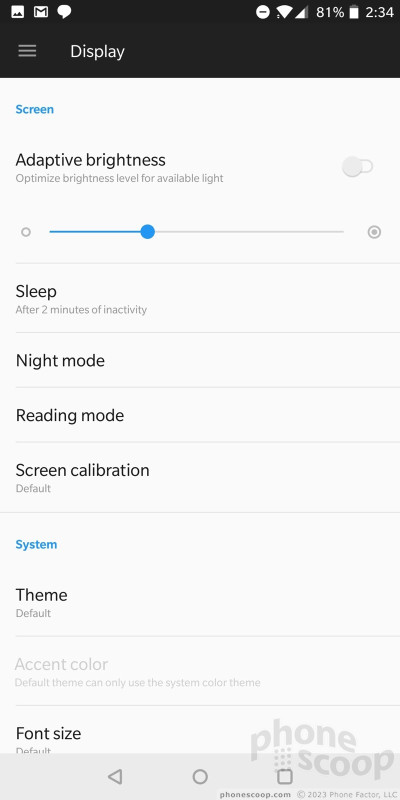





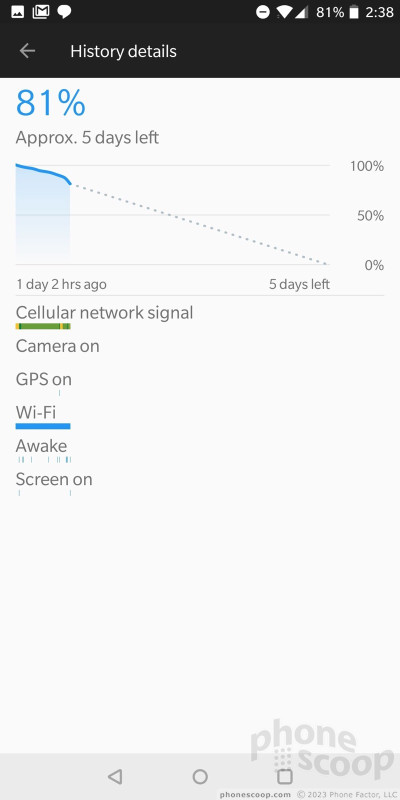



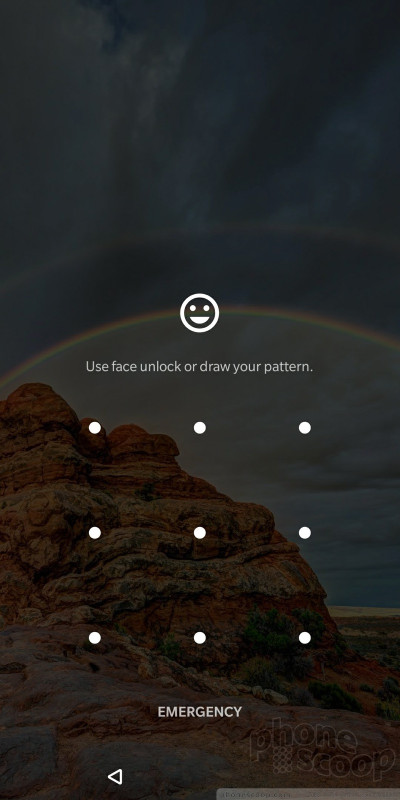









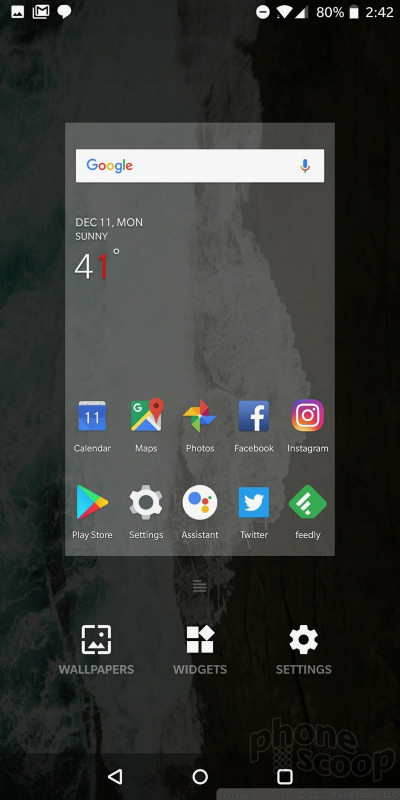










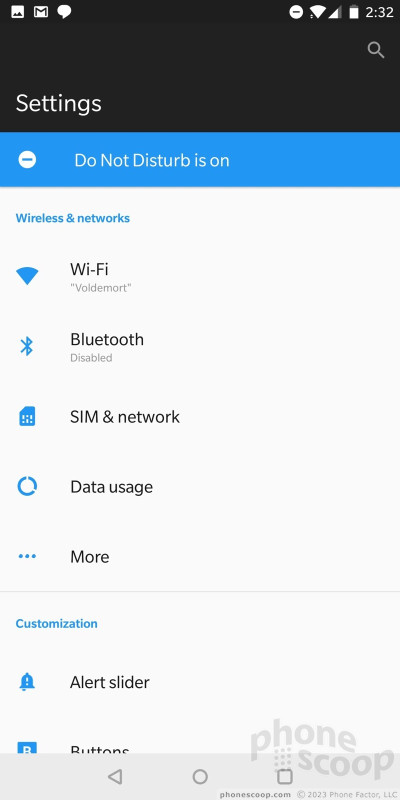













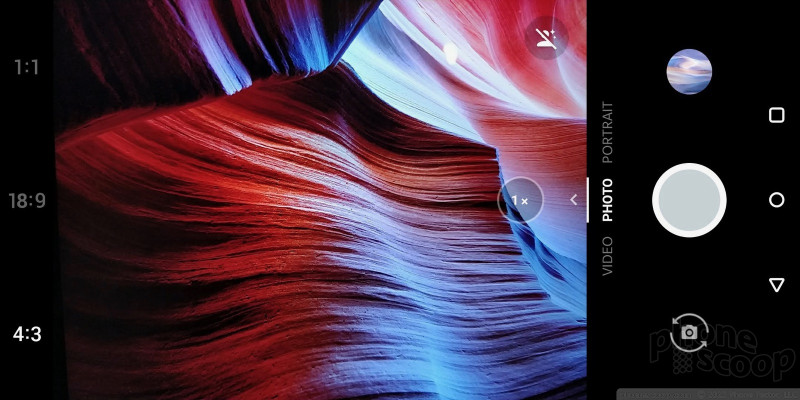


















 Hands On with the OnePlus 5T
Hands On with the OnePlus 5T
 OnePlus 5T and Honor 7X Now Available In Red
OnePlus 5T and Honor 7X Now Available In Red
 OnePlus Debuts Sandstone White Color for 5T
OnePlus Debuts Sandstone White Color for 5T
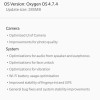 OnePlus 5T Scores OxygenOS 4.7.4 with Performance Tweaks
OnePlus 5T Scores OxygenOS 4.7.4 with Performance Tweaks
 OnePlus 5T Can't Stream HD Content from Netflix, Google, Amazon
OnePlus 5T Can't Stream HD Content from Netflix, Google, Amazon
 OnePlus 5T
OnePlus 5T









